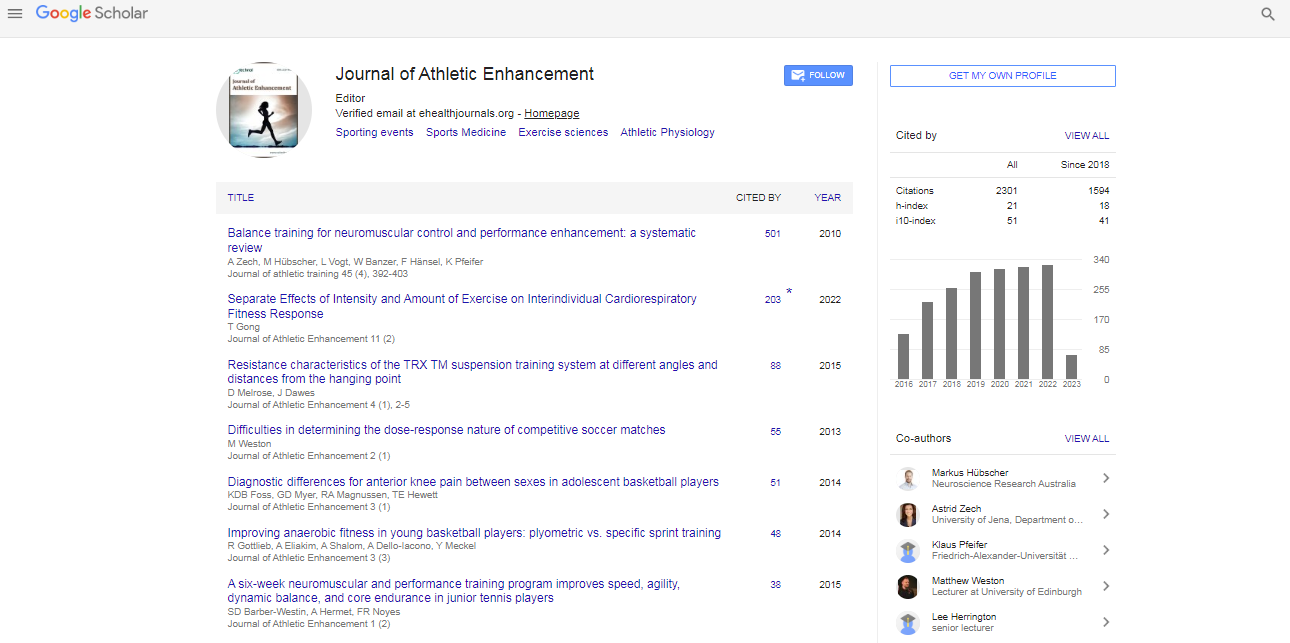Opinion Article, J Athl Enhanc Vol: 12 Issue: 6
The Transformative Power of Yoga: A Pathway to Mind-Body Harmony
Ehab Lin*
1Department of Sports, University of Pittsburgh, Pittsburgh, USA
*Corresponding Author: Ehab Lin,
Department of Sports, University of Pittsburgh,
Pittsburgh, USA
E-mail: linehab094767@hab.edu
Received date: 30 October, 2023, Manuscript No. JAE-24-124077;
Editor assigned date: 02 November, 2023, PreQC No. JAE-24-124077 (PQ);
Reviewed date: 16 November, 2023, QC No. JAE-24-124077;
Revised date: 23 November, 2023, Manuscript No. JAE-24-124077 (R);
Published date: 30 November, 2023 DOI: 10.4172/2324-9080.100089
Citation: Lin E (2023) The Transformative Power of Yoga: A Pathway to Mind-Body Harmony. J Athl Enhanc 12:6.
Description
Yoga, an ancient practice originating in India, has transcended centuries, cultures, and borders to become a global phenomenon. It’s not merely a set of physical postures but a holistic system that encompasses physical, mental, and spiritual well-being. Rooted in profound philosophical foundations, the practice of yoga extends far beyond the realms of a mere exercise routine. Its depth lies in its ability to align the body, mind, and spirit, fostering a harmonious connection with oneself and the world. At its core, yoga aims to unite the individual consciousness with the universal consciousness. The word 'yoga' itself means union, indicating the union of the body with the mind and breath, and ultimately with the greater cosmos. This union is achieved through various practices encompassing physical postures (asanas), breath control (pranayama), meditation, ethical disciplines (yamas and niyamas), and philosophical inquiry.
The physical practice of yoga involves performing asanas, or postures, which not only enhance flexibility, strength, and balance but also cultivate mindfulness and presence. Each asana holds a specific purpose, targeting different parts of the body and stimulating various energy channels (nadis) to harmonize the flow of prana, or life force. Complementing the asanas is pranayama, the practice of controlling the breath. Breath serves as a bridge between the body and the mind, and pranayama techniques allow individuals to regulate their energy and enhance mental clarity. The rhythmic control of the breath facilitates a deeper connection between the physical body and the subtle energy systems.
Yoga delves into the realms of mental tranquility through meditation and mindfulness practices. Meditation cultivates awareness and inner peace by quieting the fluctuations of the mind. It encourages individuals to observe their thoughts without attachment, fostering a sense of calmness and clarity. The regular practice of meditation helps in reducing stress, anxiety, and promoting emotional resilience. Mindfulness, an integral part of yoga, encourages being present in the moment. By directing attention to sensations, thoughts, and emotions as they arise without judgment, individuals develop a deeper understanding of themselves and their reactions to the external world.
Yoga isn’t confined to physical poses or breathing techniques; it encompasses ethical guidelines known as yamas and niyamas. Yamas focus on universal moral principles such as non-violence (ahimsa), truthfulness (satya), non-stealing (asteya), non-excess (brahmacharya), and non-possessiveness (aparigraha). Niyamas involve self-discipline, self-study, contentment, self-surrender, and purity. Additionally, the philosophical aspects of yoga, as outlined in ancient texts like the Yoga Sutras of Patanjali, delve into the nature of the mind, the causes of suffering, and the pathways to liberation (samadhi). These teachings provide a framework for understanding the human experience and offer guidance on how to navigate life's challenges with equanimity.
In today's fast-paced world, where stress, sedentary lifestyles, and mental health issues prevail, yoga has emerged as a potent antidote. Its adaptability allows people from all walks of life to benefit from its practices. Whether it's in the form of gentle yoga for stress relief, vigorous vinyasa for strength and flexibility, or meditative practices for mental clarity, yoga caters to diverse needs. Moreover, numerous scientific studies have validated the benefits of yoga, showing its efficacy in reducing stress, improving physical health markers, enhancing cognitive function, and promoting overall well-being. As a result, yoga has been increasingly incorporated into wellness programs, schools, workplaces, and healthcare settings globally.
The true essence of yoga transcends the confines of a yoga mat; it extends into daily life. It encourages individuals to embody its principles off the mat-cultivating compassion, mindfulness, and conscious living. Integrating yoga into one's lifestyle involves conscious choices in diet, relationships, work-life balance, and overall well-being. Yoga isn’t just a practice; it's a way of life that fosters harmony within oneself and with the world. Its profound teachings offer a pathway to self-discovery, healing, and transformation. By embracing the physical, mental, and spiritual dimensions of yoga, individuals can embark on a journey of selfawareness, leading to a more balanced and fulfilling life.
 Spanish
Spanish  Chinese
Chinese  Russian
Russian  German
German  French
French  Japanese
Japanese  Portuguese
Portuguese  Hindi
Hindi 
